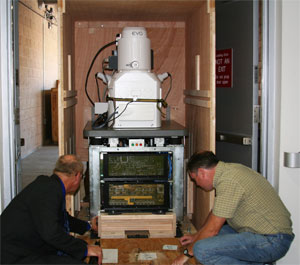Head of Corporate Research and Technology at Carl Zeiss Visits Calit2 at UCSD
By Tiffany Fox, (858) 246-0353, tfox@ucsd.edu
San Diego, CA, July 21, 2008 -- The senior vice president for corporate research and technology at Carl Zeiss AG visited the California Institute for Telecommunications and Information Technology (Calit2) at UC San Diego's Atkinson Hall last week and suggested potential areas of research collaboration with the institute.
|
Stietz's UCSD tour included a stop at the Calit2 Nano3 laboratories, where Nano3 Clean Room Manager Bernd Fruhberger pointed out that several pieces of Zeiss equipment — three Axio Imager Optical microscopes and an EVO 60 column as part of a Raith electron-beam writing tool — are already being used in the Metrology lab. UCSD Professor of Chemistry and Biochemistry Andy Kummel described his team's research into epithelial cells from human breast tissue, which they scan using a Zeiss microscope to determine with a high degree of certainty whether or not they are cancerous.
Next up on the tour was a stop at Calit2's HIPerSpace display, the highest-resolution computer display in the world. Stietz got a super high-res look at a cross-section of a rat's brain and pinpointed Lake Constance in his native Germany on the display's 287-million-pixel rendering of the earth as seen from space. Larry Smarr, director of Calit2, noted that such detailed, high-resolution images will be increasingly critical for research in global warming.
The Zeiss representative was also treated to a screening of several 4K digital video clips, including a scene from the film "Baraka," a segment from the operatic "Era La Notte" and a short film called "24 Flowers," which features high-resolution still shots of exotic flora. (Zeiss is a major manufacturer of camera and cinematography lenses.)
"This technology is actually changing the business model of theaters," Smarr said, pointing out that "Era La Notte" was originally streamed live from Amsterdam as part of Calit2's involvement in the CINEGRID @ Holland Festival in 2007. "We could create a film like '24 Flowers' with images from a microscope just as well. We're quite interested in using this for science imagery."
Dean of the Jacobs School of Engineering Frieder Seible (who invited Stietz to visit UCSD) and Calit2 post-doctoral researcher Jurgen Schulze demonstrated the institute's additional capabilities for displaying science imagery at the StarCAVE virtual reality system, where Stietz was able to "walk through" a three-dimensional rendering of a protein molecule. Schulze explained that the protein structures were downloaded from the Protein Data Bank and converted to a compatible 3-D file for viewing and analysis in the StarCAVE. Seible added that the technology could also be used for multi-slice microscopy, and when combined with powerful software that only scans cancer cells, would eventually eliminate the need for a pathologist to analyze data.
|
"With this type of 3-D, virtual reality imaging," he continued, "you could even walk around on the surface of a microchip. I imagine this technology is the microscope of the future. You won't even need a microscope if you have one of these ."
The day's events concluded with a presentation by Stietz, which included an overview of Zeiss' corporate structure, innovation strategies, employee development, and areas of potential collaboration with Calit2 at UCSD.
Zeiss is worth 2.6 billion euros, employs 12, 257 people and earns nearly 20 percent of its revenues in the U.S. Its market sections include medical and research solutions (including microscope systems for genetics, cancer research, molecular medicine and drug development), industrial solutions (including nanotechnology, industrial metrology and semiconductors) and lifestyle products (including planetarium technologies and Carl Zeiss Vision eyewear).
To promote innovation and employee development, Carl Zeiss hosts annual internal innovation days, which provide a platform for communication and innovation to more than 200 employees and help promote "communities of practice." In addition, Carl Zeiss also recognizes its employees with innovation awards in several different categories, including a "successful failure" prize, which elicited chuckles from the audience.
"You're laughing, but I think this really a very essential innovation award. You can get a prize for failure you had on a project, but only if you have demonstrated you have learned from your mistakes," Stietz said.
He continued: "The message here is that Carl Zeiss is giving money into R&D in order to have a focus on innovation and new products. But money isn't everything. You also need to have a culture of innovation."
In addition, Stietz mentioned several research areas in which collaborations with Calit2 might be possible. Those areas include 3-D visualization and software architecture, nanotechnology (including near field optical systems and nanoparticle metrology), molecular and multimodal imaging (especially hyperspectral imaging) and metrology (especially nanometrology).
"It's remarkable how much Zeiss invests in research and technology developments," commented Ramesh Rao, director of Calit2 at UCSD. [Carl Zeiss currently spends roughly 11 percent of its sales revenues on R&D.] "This is something that is close to the hearts of us who like to see university innovations go into the field. Stietz is responsible for a very significant budget and a large number of staff members, so I think this augurs well for the many initiatives that we are trying to put in place as we move forward."
Media Contacts
Tiffany Fox, (858) 246-0353, tfox@ucsd.edu
Related Links
Carl Zeiss



